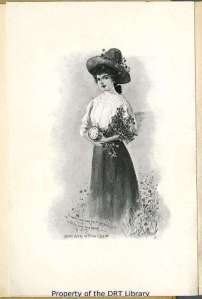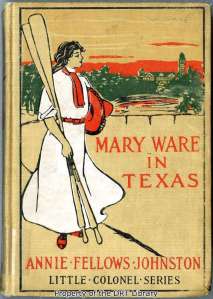Fiesta, 1910: “It’s Enough to Make One Want to Live Here Always”
We recently came across a charming item documenting the early history of the Battle of Flowers Parade and the Order of the Alamo court: Mary Ware in Texas, a children’s book published one hundred years ago, provides an example of how each has been portrayed in popular culture.
Mary Ware was a character in Annie Fellows Johnston’s immensely popular and semi-autobiographical Little Colonel children’s series. The books focused on the adventures of Lloyd Sherman, a young girl whose fierce mannerisms echoed the traits of her grandfather, a Confederate colonel in the Civil War, and earned her the moniker “the Little Colonel.” Johnston (1863-1931) based the title character on five-year-old Hattie Cochran, whom she met in Kentucky in the early 1890s. The Little Colonel series eventually comprised twelve volumes published between 1895 and 1912; Shirley Temple played in the title role in the 1935 film adaptation.

The frontispiece illustration in Mary Ware in Texas, showing the title character in a field of bluebonnets.
Johnston introduced the character Mary Ware in Mary Ware: The Little Colonel’s Chum (1908), written in response to a flood of fan inquiries. Johnston wrote both that book and Mary Ware in Texas (1910) towards the end of her eight years residing in Boerne; the latter was finished around the time her stepson, John, died of tuberculosis at age twenty-nine.
Chapter 14 in Mary Ware in Texas focuses on Mary and her friends sightseeing in San Antonio during “San Jacinto Day” (now Fiesta San Antonio). Preliminary research does not indicate how Johnston obtained information about the various events she described. In a letter written from her home in Boerne on April 19, 1908, Johnston stated, “The Carnival begins tomorrow in San Antonio with its Battle of Flowers and parades, and we are thankful we are up in the hills ‘far from the maddening crowd.'” While Johnston may have attended Fiesta events other years during her time in Texas, she may have also relied on secondhand sources (e.g. stories from friends or detailed accounts published in the newspaper).
In the book, Mary and her friends first attend the coronation of the Court of the Roses. Johnston apparently created characters who were members of the 1909 and 1910 courts in the story but not in real life. However, a comparison of Johnston’s account with details provided in the Order of the Alamo’s official history (shown below) indicates that she did accurately depict the opulence of the coronation 1910 ceremony, which in reality was only the second one held by the Order. “Look at Mary’s rapt expression!” her friend observes during the ceremony. “She’s always adored queens and such things, and now she feels that she’s up against the real article.”

Two pages from the first volume of the History of the Order of the Alamo describe the 1910 Court of the Roses and its coronation.
Following the coronation, Mary and her friends visit the illuminated San Antonio River, described in the book this way:
[Billy Mayrell] led them to a place where they could look across a bend and see one of the bridges. It was strung so thickly with red lights which outlined every part, that it seemed to be made of glowing rubies, and its reflection in the water made another shining ruby bridge below, wavering on the dark current.
Mary leaned over the rail watching the shimming lights, and feeling dreamily that this City of the Alamo was an enchanted city; that the buildings looming up on every side were not for the purpose of barter and trade. They were thrown up simply as backgrounds for the dazzling illuminations which outlined them against the night sky. The horns of the revellers answering each other down every street, the music of distant bands, the laughter of the jostling throngs, all deepened the illusion…
[The city] was a realm given over utterly to “Mirth and Merriment,” where a gracious young queen held sway, where illness and trouble and grief had no part.
“I don’t wonder that the Major wants everybody not already a loyal Texan to see this,” [Mary] said to the Lieutenant. “It’s enough to make one want to live here always” (343-345).
![[Battle of Flowers Parade, 1911] Postcard showing the Alamo decorated for the Battle of Flowers Parade and Helena Guenther, Queen of the Court of Carnival Flowers, 1911.](https://drtlibrary.files.wordpress.com/2010/04/sc-col-10931-postcard-showing-the-battle-of-flowers-parade-1911wtmk1.jpg?w=194&h=300)
A postcard showing the Alamo decorated for the Battle of Flowers Parade and Helena Guenther, Queen of the Court of Carnival Flowers, 1911.
Finally, the next day, Mary and her friends attend the Battle of Flowers Parade, which they watch from the backseat of an automobile:
Back and forth in front of the Alamo went the two divisions of the parade, meeting and passing and turning to meet and pass again, all the while pelting each other with flowers, till the plaza where they rode was covered deep with them. And the bands played and the people cheered, till the smallest schoolboy in their midst felt a thrill of gratitude to the heroes whose deeds they were commemorating. He might miss the deeper meaning of it all, but he grasped one fact clearly enough: that had it not been for the grim battle which those brave fellows fought to the death, there would have been no San Jacinto Day for him. No pageant-filled holiday to make one feel that it is a great and glorious thing to be a son of the Lone Star State (346).
References and Further Reading
The Little Colonel website, http://www.littlecolonel.com, is authored by Donna Russell and provides a wealth of information about the series, including a biography of author Annie Fellows Johnston, descriptions of real people and places that inspired characters and locations in the stories, and full texts of each work.
Photographs of Annie Fellows Johnston and Hattie Cochran are available through the digitized Kate Matthews Collection, available through the University of Louisville Libraries.
The five-volume History of the Order of the Alamo, available at the DRT Library, contains information about each court between 1909 and 1989, including photographs of each queen, princess, and duchess during that period.
For more information about how the history of the Battle of Flowers Parade is documented in archival collections at the DRT Library, see last year’s entries about the event on the “Inside the Gates” blog. One post focused on the parade’s beginnings and earliest years; another highlighted photographs of participants and floats in the late 1800s and early 1900s, around the time Mary Ware in Texas takes place; and a third featured footage of the 1971 and 1976 parades.
Click here for a full citation of the documents and images included in this entry.



Trackbacks